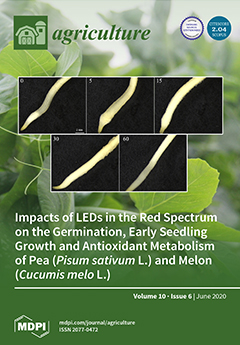Twenty-four Dorper x Pelibuey lambs were housed in individual pens during a 31-d feeding period and assigned to four treatments (
n = 6) under a randomized complete block design with different daily doses of zilpaterol hydrochloride (ZH): 0 (control), 0.1, 0.2, and
[...] Read more.
Twenty-four Dorper x Pelibuey lambs were housed in individual pens during a 31-d feeding period and assigned to four treatments (
n = 6) under a randomized complete block design with different daily doses of zilpaterol hydrochloride (ZH): 0 (control), 0.1, 0.2, and 0.3 mg/kg BW to determine the effects of ZH supplementation on productive performance, meat quality, and wholesale cut yields. Final BW (
p = 0.02) and average daily gain (ADG,
p = 0.04) were greater in lambs supplemented with 0.2 mg/kg BW. Supplemental ZH tended to improve dry matter intake (DMI,
p = 0.008) and ADG:DMI ratio (
p = 0.078). Wholesale cut yields were not affected by ZH supplementation. Percentage of head was greater (
p = 0.04) in lambs treated with ZH. The ZH supplementation did not affect carcass characteristics. However, longissimus thoracis et lumborum (LTL) presented a linear trend (
p = 0.08) of increasing with ZH supplementation. Percentage of blood presented a trend (
p = 0.051) of decreasing with ZH supplementation. Also, liver decreased in size (
p < 0.05) for treatments where ZH was included. Values of luminosity decreased (
p < 0.02) when ZH dosage increased. The value of protein Lowry was greater, with 0.3 mg kg
−1 (
p = 0.04). Cathepsin B + L was greater in the lambs from the control treatment (
p = 0.05). In conclusion, using a daily ZH dosage of 0.2 mg per kg of BW produced the best productive performance, carcass characteristics, and some changes in the meat of hair-breed lambs.
Full article





